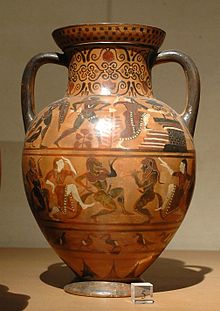Pontic Group
The Pontic Group (or Pontic vases) is a sub-style of
black-figure vase painting
.

Stylistically, Pontic vases are very closely related to
and other shapes occur rarely. The artistic scheme of Pontic vases is uniform. Usually, they bear ornamental decoration on the neck, followed by figural motifs on the shoulder, then a further ornamental band, an animal frieze and a ring of rays. Foot, part of the neck and handles are black. The importance of the ornaments is striking. Some of the vessels bear purely ornamental decoration.
The clay of Pontic vases is yellowy-red. The shiny
Titios Painter. Non-mythological scenes include komasts
and horsemen. The vases are dated between 550 and 500 BC. None bear inscriptions. About 200 pieces are known as yet.
Bibliography
- Pericle Ducati: Pontische Vasen. (= Forschungen zur antiken Keramik Reihe 1, Bd. 5) Keller, Berlin 1932.
- Tobias Dohrn: Die schwarzfigurigen etruskischen Vasen aus der zweiten Hälfte des sechsten Jahrhunderts. Ph.D. Köln 1936, p. 33–89. 145–151.
- John Beazley: Etruscan vase painting. Clarendon Press, Oxford 1947, p. 12.
- Enrico Paribeni: Pontici, Vasi. In: Enciclopedia dell'Arte Antica. Vol. 6, Rome 1965 Digitalisat
- Birgitte Ginge: Ceramiche Etrusche a figure nere. Materiali del Museo Archaeologico Nazionale di Tarquinia XII. Bretschneider, Rome 1987.
- Maria Antonietta Rizzo: La ceramica a figure nere. In: Marina Martelli (ed.): La ceramica degli Etruschi. Istituto Geografico de Agostini, Novara 1987, p. 31–35.
- John Boardman: Early Greek Vase Painting. Thames and Hudson, London 1998, p. 219–223.
- Matthias Steinhart: Pontische Vasenmalerei. In: Der Neue Pauly, vol. 10, cols. 138-139.
- ISBN 3-8062-1743-2.
Wikimedia Commons has media related to Pontic group.
